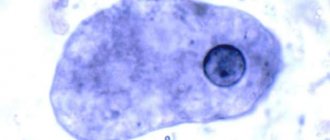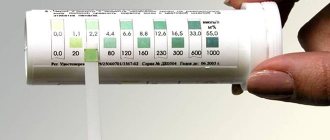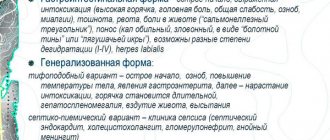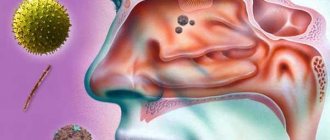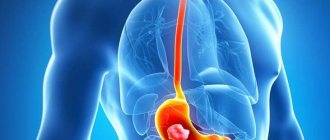Helminthiasis is a disease caused by infection with helminths (parasitic worms). The most common individuals that infect the human body are round and flatworms; in rare cases, ringed and spiny-headed representatives are found. The disease most often has a chronic form and manifests itself in the form of abdominal, allergic symptoms, decreased hemoglobin in the blood and others, depending on the type of worm.
Sites of parasitism can be in different parts of the body - in the lungs, liver, brain, organs of vision. To correctly determine the degree of infection, diagnosis of helminthiases is necessary. Timely testing will help determine the type of parasite and determine the correct therapy.
Types of helminths and their habitat
Helminths enter the body through the esophagus and then spread throughout the body. The same food that a person consumes or processed products are used as food.
The human body is most often parasitized by two types of helminths:
- Flat - this includes cestodes (tapeworms) and trematodes (flukes). The thin membrane of the body is also an organ for absorbing vitamins and other nutrients. Representatives of the species include pork, dog, dwarf tapeworm, and wide tapeworm. Toxic waste produced by parasites causes stress, anemia, intestinal upset, abdominal pain, nausea, weakness, and weight loss.
- Round nematodes are trichinella, roundworms, whipworms, pinworms. Most often they parasitize in the lungs, liver, brain, organs of vision or hearing. When affected by this type of helminth, a person experiences increased gas production, pain in the intestines and abdominal cavity, intestinal upset, weakness, and dry cough.
If a person is healthy, then his body is able to cope with the problem itself. This occurs due to a special protective system: salivary enzymes, gastrointestinal acidity and immunity. If any of the components of the protection fails, then a favorable environment is created for the penetration of worm larvae and eggs. They enter the body and begin to parasitize it.
Blood test
The second most commonly used method for detecting parasites is blood testing. Laboratory diagnosis of helminth infections can be based both on the direct detection of migrating helminth larvae, and on the study of the body’s immune response to the penetration of a foreign form of life.
This method of examination is the most informative in the initial stages of the disease, when helminths go through the migration stage. Sexually mature forms of the worm that live in the intestines are practically not detected by blood tests. The classification of blood tests for signs of parasitic diseases includes two types of analysis.
The biomaterial is collected by a laboratory assistant or nurse. Blood for testing is taken from a vein or finger. The first method is more preferable, as it allows you to obtain a larger amount of material and thus increase the reliability of the results. The blood must be delivered to the laboratory immediately, after which material for research is immediately prepared from it.
If identification of the larval species is not required, the blood can be used in its pure form, without preparing a drug. To do this, apply a thin layer of Vaseline square onto a glass slide, into which a drop of material is dropped. The resulting mixture is implanted with a second glass and examined under a microscope. As a rule, it is possible to examine the microfilariae located between the formed elements of the blood. They remain mobile for 6 hours, after which they die. However, even dead larvae remain visible under a microscope.
Causes of infection
The main cause of infection is the lack or non-compliance with personal hygiene rules. To avoid infection, it is important to know all the ways helminths enter the body, except the gastrointestinal tract. Diagnosis of worms in humans reveals the following ways and causes of helminthiasis:
Lack of or non-compliance with personal hygiene rules:
- Eating and preparing food occurs with dirty hands;
- Visits to dubious food outlets, where Sanpin norms are most often violated;
- Helminth eggs enter a house or apartment along with outdoor shoes;
- Living together with domestic animals can cause infection or through contact with wild animals;
- Swimming in wild bodies of water and accidentally swallowing water can also lead to infection.
Poorly refined or processed foods:
- Eating fruits and vegetables that have not been thoroughly washed;
- Consumption of undercooked animal products such as eggs, meat, fish;
- Quenching thirst from questionable sources (street wells, wells) or milk that has not been pasteurized;
- Eating undercooked or dirty meat during street picnics.
Weak or not yet formed immunity:
- Children and adolescents under 17 years of age;
- In women during pregnancy and breastfeeding;
- In older people.
The risk of infection increases many times if the natural microflora in the intestines is disturbed or there are diseases of the gastrointestinal tract.
Everywhere - in the air, wild bodies of water, on the wings and legs of insects - there are helminth eggs that can easily become infected. Even when washing vegetables or fruits outdoors near a pond, it is best to use specially purchased purified water.
Decoding the results
This diagnostic method is based on the detection of antibodies to parasites. To do this, testing systems measure the level of antibodies of the IgA and IgG classes. Two weeks after invasion (penetration of the pest into the blood), IgM antibodies are detected. After this, IgG antibodies are detected, which remain at elevated levels throughout the entire period of the disease.
- A high level of IgG antibodies indicates a chronic course of helminthiasis.
- When IgM antibodies are detected, we can talk about the acute phase of the disease.
- High concentrations of IgM and IgG indicate an exacerbation of the chronic process.
- Indicators of norm and pathology
- A negative result means that antibodies to parasites are not detected in the body.
- A positive answer indicates infection with worms (specific and quantitative).
- If the result is borderline, you need to donate blood again after two weeks.
Note! The result may come back negative for certain types of helminths, while the body may be affected by other pests. They also need to be tested and donate blood.
As an additional diagnosis, a specialist may prescribe: a general blood test, biochemistry, and a stool test for helminth eggs.
Symptoms of helminthiasis
Diagnosis of helminths is an opportunity to correctly identify the disease, because often a person is bothered by ailments, but he does not understand the cause of their occurrence. Or these symptoms may be so insignificant that he simply does not pay any attention to them.
Each type of parasitic worm has its own symptoms. Ascariasis, caused by roundworms, manifests itself as follows:
- Decreased appetite;
- Constant occurrence of causeless nausea;
- The occurrence of pain in the abdominal cavity;
- Intestinal upset in the form of constant diarrhea and constipation;
- Frequent headaches;
- State of neurosis;
- Insomnia.
The parasitizing environment for roundworms is the liver, intestines, and lungs. When worms enter these organs, a person also experiences a cough, fever, and anemia.
Whipworm causes a disease called trichocephalosis, which manifests itself as follows:
- Increased gas formation in the intestines;
- Intestinal disorder;
- General toxicosis of the body;
- Permanent weight loss;
- Frequent occurrence of colds, weakened immune system;
- Damage to the microflora of internal organs;
- Anemia.
Whipworms manifest themselves especially sharply in children's bodies, provoking the occurrence of colds. Adults also feel constantly tired.
Pinworms are the cause of enterobiasis and have their own symptoms:
- Constant feeling of burning and itching in the anal area;
- Grinding of teeth during sleep;
- Decreased tone, the occurrence of apathy and lethargy;
- Intestinal disorder;
- Disgusting breath;
- The appearance of dark circles under the eyes.
If any of these symptoms occur, the best way to identify worms is to get them diagnosed.
There are also general symptoms that are characteristic of all types of helminths that parasitize the human body. These include:
- Intestinal upset in the form of alternating diarrhea and constipation;
- Itching and burning in the anal area;
- Feeling of discomfort, pain in the abdominal cavity, high gas formation;
- Slight increase in body temperature for a long time;
- A professional study revealed an increase in the natural size of the liver and spleen;
- Poor appetite or excessive gluttony;
- Disturbance of microflora in the digestive organs and the development of inflammatory processes in them;
- Poor absorption of nutrients into the walls of the small intestine;
- Intestinal obstruction;
- Lack of water in the body;
- Constant bouts of vomiting, nausea;
- Pain in the chest area, coughing;
- The appearance of allergic skin rashes and itching;
- Being in a state of stress, having a constant feeling of fatigue;
- The occurrence of frequent headaches;
- The occurrence of disorders in the field of neurology.
Some common symptoms overlap with those that appear in certain types of worms. This once again emphasizes the importance of diagnostics for timely treatment.
Threat to the body
Helminths are a type of parasite that has a damaging effect on the entire human body. What exactly is the threat?
- The products of worm processing are poison for the entire body, which causes a constant feeling of fatigue, insomnia, and low performance;
- The nutrient medium for worms is the vitamins, minerals, carbohydrates, proteins that enter the body, as well as some cells important for the functioning of internal organs;
- Traces from helminth suckers have a destructive effect on the tissues and mucous membranes of internal organs;
- The presence of parasites causes gastrointestinal upset;
- Worms attack the human immune system, so during the period of infection he is often exposed to colds;
- Worms are mobile and quickly spread throughout the body, which has the most detrimental effect on the activity of all internal organs;
- Helminths pose a threat to the unborn baby - penetrating through the placenta, they infect the fetus, weaken its immunity, which threatens a large number of diseases after birth;
- When infected with worms, the nervous system suffers, resulting in the appearance of neurological disorders and deterioration of mental state.
Methods for diagnosing helminths
It is important to understand what the diagnosis of helminthiases in humans is. There are a number of methods that can detect the presence of parasites in the body. There are two of them - direct and indirect.
The direct method makes it possible to immediately determine the presence of a worm and its larvae. The indirect view diagnoses secondary signs of the presence of helminths.
How to diagnose worms
Diagnostic methods:
- Macroscopic - is an analysis of human feces. Sometimes the number of parasites is so large that they can be seen in feces with the naked eye. How is macroscopic analysis performed? The feces are placed in a special container (a shallow glass or plastic cup with a lid) and the presence of worms is examined through a magnifying glass. In this way, even the smallest worms can be detected. Typically, this diagnostic method is used to determine the presence of pinworms and roundworms.
- Microscopic is a method for detecting eggs and larvae of worms, which is carried out using the Kato method (clarification of a thick smear with glycerin). This method involves taking a thick smear and then examining it on a special membrane. This type of examination is not ideal as it may miss traces of some types of worms. For better diagnosis, the microscopic method is combined with coproovoscopy (contrast staining). The number of individuals is usually viewed by combining the Kato and Stoll methods (counting helminth eggs).
- Immunological – methods for detecting the presence of antibodies to a particular type of helminth in the blood plasma. Methods include: enzyme immunoassay, passive hemagglutination method, immunoelectrophoresis, immunosorption. Immunological diagnostic methods make it possible to detect a large number of diseases associated with parasites (alveococcosis, echinococcosis, ascariasis, cysticercosis).
- Biopsy is a method used to establish an accurate diagnosis of the presence of worms in human muscle tissue. Muscles are the site of Trichinella parasitism. For diagnosis, the patient undergoes the procedure of pinching off a small piece of tissue. The resulting biopsy is carefully examined under a microscope.
- Examination of duodenal contents - carried out if there is a suspicion of the presence of helminths in the internal organs (liver, gall bladder or duodenum). A mixture of bile, gastric juice, chyme of the pancreas and duodenum is taken for analysis.
- Electropuncture – refers to hardware methods for diagnosing diseases. Acupuncture points are exposed to a weak current, after which the skin resistance is analyzed. Electropuncture diagnostics is carried out in two ways - vegetative resonance testing and the Voll method (study of skin resistance on the fingers and toes).
- Instrumental methods make it possible to determine how badly internal organs are damaged by worms and their products. Instrumental diagnostic methods include ultrasound, x-ray, computed tomography.
As soon as the research is carried out and a diagnosis is made for the presence of parasites, it is necessary to immediately begin treatment.
In what order is diagnostic testing performed?
In most cases, diagnosis of helminthiasis is carried out according to the following plan:
- After receiving a complaint from the patient, the doctor prescribes laboratory or instrumental diagnostic methods to establish a preliminary diagnosis. This includes a general blood test, which allows you to determine what changes in the body have occurred due to infection with worms.
- Stool analysis also refers to laboratory methods. It can be used to detect the presence of worms in feces, as well as their type (round or flat).
- To establish the exact number of types of parasites and eliminate any errors in establishing an accurate diagnosis, studies are carried out using the Kato and Stoll methods (highlighting and contrast staining).
- After taking blood for analysis, a serum enzyme immunoassay is prescribed. If the presence of antibodies to any type of parasite is detected, then their presence will become a confirmed fact.
In order for the diagnosis to be successful, the patient undergoes a comprehensive examination, which includes, in addition to blood and stool tests, all of the above studies that will help detect the presence of parasites in muscle tissue, the liver and gall bladder and their destructive effect on all internal organs through ultrasound and x-ray , FGDS.
How to get tested for worms
To get tested for worms, you need to have a referral from your local physician. Most examinations do not require preparation, and if there are nuances, the doctor will explain them when ordering the examination. In order for a doctor to write a referral, indications are required.
In commercial clinics you can get tested regardless of the indications. The price varies significantly. The time to obtain the results of stool and scraping is about a week, the analysis of urine, sputum, and blood is about 2 days, depending on the workload of the laboratory.
Preventive measures
The main thing to start with in preventing helminthiasis is to instill in a person, starting from an early age, a love for a healthy lifestyle. To avoid infection, you must follow several rules:
- Use only filtered water for drinking and washing fruits and vegetables;
- Use individual personal hygiene items, especially in other people’s places (towels, toothbrushes and other everyday items);
- If there are animals in the house, they must be regularly vaccinated and dewormed;
- During the harvest period, avoid eating poorly washed vegetables and fruits, as they say, directly from the garden, otherwise, along with the soil, you can get worm eggs with all the ensuing consequences;
- For lovers of sushi and rolls, it is best to avoid eating raw fish (cafes offer sushi and rolls baked or with smoked fish); all products of animal origin must undergo careful heat treatment.
Preventive measures also include the use of medications if there is at least one of the indications:
- Presence of animals in the house or work related to caring for them;
- The child’s attendance at kindergarten or other educational institution;
- Availability of a garden plot;
- Hobbies such as fishing or hunting;
- Passion for exotic tours.
Prevention with medications is carried out once every six months. This must be done by all family members to avoid re-infection. Albendazole is recognized as the best medicine. It is prescribed to children from two years of age and adults one tablet (400 milligrams) once a day. The drug must be taken three days after meals.
Scotch test
The term “tape test” refers to taking a scraping from the peri-anal folds using adhesive tape. The procedure is only relevant for detecting pinworm eggs. As for the people who are undergoing the procedure, they are being prepared. Thus, 3 days before taking a sample, it is prohibited to take antihelminthic medications. In the evening, as well as in the morning before the collection of biomaterial, no hygienic measures are taken for the anus and genital area.
The test itself is not difficult. It is necessary to stick a small piece of adhesive tape on the anus and perianal area of the patient, wait a few seconds and tear it off with a sharp movement. After this, the tape is glued to the glass and sent to the laboratory.
The material obtained as a result of the tape test is examined microscopically. If necessary, the laboratory assistant stains the material. Unfortunately, using such a simple method, only enterobiasis is diagnosed. Other helminthiasis cannot be detected using the tape test.

